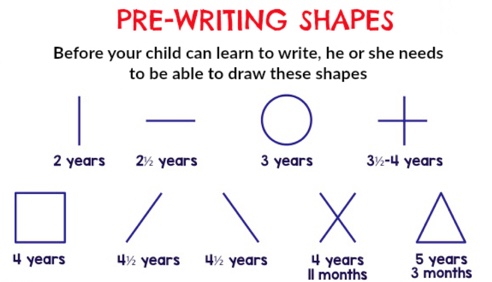Question
What shapes do children need to be able to draw in order to be ready for handwriting?
Answer
This figure shows lines and shapes per developmental level.

This is where you want them to be developmentally. They need to be able to draw these independently without a model. The vertical line is drawn first because it does not require crossing the midline of the body. At two and a half, children will start crossing midline and creating a horizontal line. At three years, they start to draw a full circle. At two and a half, you might see circular scribbles, but you see a perfect circle at three years. At three and a half to four years, they can make the two steps of the cross. Four years old is when they can start to really draw an accurate square. Now, at three and three and a half, they might imitate a square, but a lot of times, it will have curved corners and not distinct corners for a square. Oblique lines, or diagonal lines, come into play at about four and a half years old. This is where X's are important. They use diagonal lines in all those letters that I mentioned earlier. Finally, they can put it all together to make a triangle at five years old. A diamond shape is closer to six years old. It is really easy to teach writing shapes, especially to preschoolers or even younger ones. I make silly sounds as I am teaching it. I also sing The Wheels on the Bus while they are drawing. For example, "The people on the bus go up and down" for the vertical line. "The wipers on the bus go back and forth," for the horizontal. The wheels could be the circle and so on.
This Ask the Expert is an edited excerpt from a course entitled Developmental Skills for Handwriting, by Dena Bishop, OTR/L.
